OUR SERVICES
FIRE EXTINGUISHERS
IN CUMBRIA
TAKE A LOOK
BROWSE OUR FIRE EXTINGUISHER RANGE
Beacon Fire Protection supplies high-quality extinguishers to homes and businesses across Cumbria; including Carlisle, Penrith, Kendal and Workington. Ensure you have the right extinguisher on hand when you need it. Our certified engineers will site, mount and label each unit in line with UK fire safety regulations.
SUPPLY & INSTALLATION
END TO END FIRE
EXTINGUISHER SERVICES
We provide, install and commission all extinguisher types to suit your premises and risk profile.
SERVICE, REPAIR & REFILLS
ROUTINE MAINTENANCE THAT MEETS STANDARDS
Annual Servicing & Inspections
Scheduled maintenance and safety checks to ensure all equipment is compliant and fully operational.
Pressure & Hydrostatic Testing
Critical testing and part replacement to meet standards and maintain system integrity.
Immediate On-Site Refills
Rapid refilling service after any discharge to restore full functionality without delay.
Certification & Compliance Records
Complete documentation, tagging, and digital records for regulatory and audit readiness.
QUICK GUIDE
TYPES OF FIRE EXTINGUISHERS
No single fire extinguisher works on every fire class.
Electrical, flammable liquid, cooking oil and solid combustible fires each require a specific extinguisher.
Type: Water fire extinguisher
Label colour: Bright red
Use for: Paper, wood, textiles, cardboard, coal
Do not use on: Electrical fires, kitchen fires, flammable liquids/gases
How it works: Cools burning material to stop combustion
Best for: Offices, schools, hospitals, homes, warehouses
Placement: Near exits on floors with Class A fire risk
Variants:
- Water spray: Covers wider area, faster suppression
- Water mist: Microscopic particles suffocate fire and reduce heat exposure
Type: Foam fire extinguisher
Label colour: Cream
Use for: Paper, wood, textiles, cardboard, coal (Class A); Flammable liquids like petrol and paint (Class B)
Do not use on: Kitchen fires; Electrical fires; Flammable metals
How it works: Cools burning material. Forms a barrier over flammable liquids to block oxygen
Best for: Offices, schools, hospitals, homes, warehouses. Sites storing flammable liquids
Placement: Near exits on floors with Class A or B fire risks
Type: Standard dry powder (ABC) extinguisher
Label colour: Blue
Use for: Paper, wood, textiles, cardboard, coal (Class A); Flammable liquids like petrol and paint (Class B); Flammable gases like LPG and acetylene (Class C); Electrical fires up to 1000v
Do not use on: Cooking oil fires; Electrical equipment over 1000v; Enclosed spaces (e.g. offices, homes)
How it works: Smothers fire by cutting off oxygen supply
Best for: Chemical processing sites; Welding and flame-cutting areas; Garage forecourts; LPG dispensing plants; Large commercial boiler rooms
Placement: Near the source of identified fire risk
Specialist types:
- L2: For lithium fires only
- M28: For other flammable metals like titanium and magnesium
Type: CO₂ fire extinguisher
Label colour: Black
Use for: Flammable liquids like paint and petrol (Class B); Electrical fires
Do not use on: Kitchen fires (especially chip-pan fires); Combustible materials like paper, wood, or textiles; Flammable metals
How it works: Displaces oxygen to suffocate the fire
Best for: Offices, Kitchens, Construction sites, Server rooms, Work vehicles (2kg CO₂ recommended)
Placement: Near the fire risk source and/or fire exits
Type: Wet chemical fire extinguisher
Label colour: Yellow
Use for: Cooking oil and fat fires (Class F); Paper, wood, textiles, cardboard, coal (Class A)
Do not use on: Flammable liquid or gas fires; Electrical fires; Flammable metals
How it works: Forms a foam layer to block oxygen and cools the burning oil
Best for: Commercial kitchens; Canteens
Placement: Near the source of the fire risk
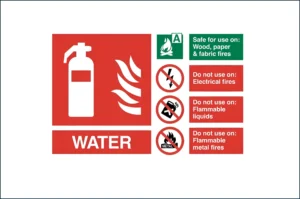
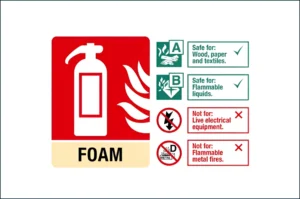
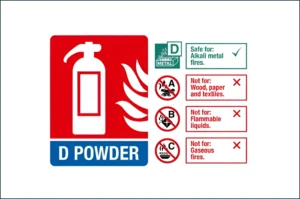
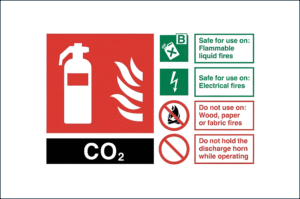
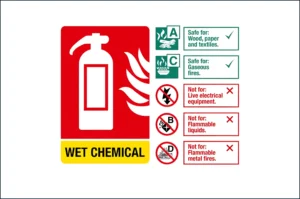
QUICK GUIDE
TYPES OF FIRE EXTINGUISHERS
No single fire extinguisher works on every fire class.
Electrical, flammable liquid, cooking oil and solid combustible fires each require a specific extinguisher.
Type: Water fire extinguisher
Label colour: Bright red
Use for: Paper, wood, textiles, cardboard, coal
Do not use on: Electrical fires, kitchen fires, flammable liquids/gases
How it works: Cools burning material to stop combustion
Best for: Offices, schools, hospitals, homes, warehouses
Placement: Near exits on floors with Class A fire risk
Variants:
- Water spray: Covers wider area, faster suppression
- Water mist: Microscopic particles suffocate fire and reduce heat exposure
Type: Foam fire extinguisher
Label colour: Cream
Use for: Paper, wood, textiles, cardboard, coal (Class A); Flammable liquids like petrol and paint (Class B)
Do not use on: Kitchen fires; Electrical fires; Flammable metals
How it works: Cools burning material. Forms a barrier over flammable liquids to block oxygen
Best for: Offices, schools, hospitals, homes, warehouses. Sites storing flammable liquids
Placement: Near exits on floors with Class A or B fire risks
Type: Standard dry powder (ABC) extinguisher
Label colour: Blue
Use for: Paper, wood, textiles, cardboard, coal (Class A); Flammable liquids like petrol and paint (Class B); Flammable gases like LPG and acetylene (Class C); Electrical fires up to 1000v
Do not use on: Cooking oil fires; Electrical equipment over 1000v; Enclosed spaces (e.g. offices, homes)
How it works: Smothers fire by cutting off oxygen supply
Best for: Chemical processing sites; Welding and flame-cutting areas; Garage forecourts; LPG dispensing plants; Large commercial boiler rooms
Placement: Near the source of identified fire risk
Specialist types:
- L2: For lithium fires only
- M28: For other flammable metals like titanium and magnesium
Type: CO₂ fire extinguisher
Label colour: Black
Use for: Flammable liquids like paint and petrol (Class B); Electrical fires
Do not use on: Kitchen fires (especially chip-pan fires); Combustible materials like paper, wood, or textiles; Flammable metals
How it works: Displaces oxygen to suffocate the fire
Best for: Offices, Kitchens, Construction sites, Server rooms, Work vehicles (2kg CO₂ recommended)
Placement: Near the fire risk source and/or fire exits
Type: Wet chemical fire extinguisher
Label colour: Yellow
Use for: Cooking oil and fat fires (Class F); Paper, wood, textiles, cardboard, coal (Class A)
Do not use on: Flammable liquid or gas fires; Electrical fires; Flammable metals
How it works: Forms a foam layer to block oxygen and cools the burning oil
Best for: Commercial kitchens; Canteens
Placement: Near the source of the fire risk





INSTALL WITH CONFIDENCE
WHY PROFESSIONAL SERVICING MATTERS
Extinguishers require the correct commissioning, installation and regular servicing. Without this, you risk voiding insurance and falling foul of fire regulations. Our end to end service ensures your equipment works instantly when it matters most.